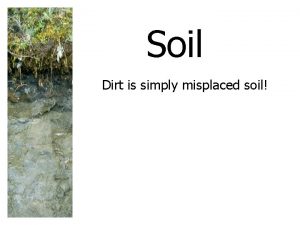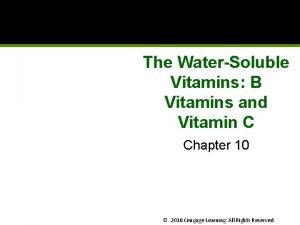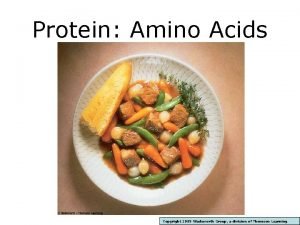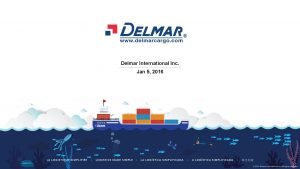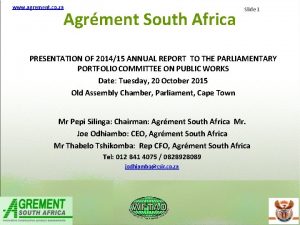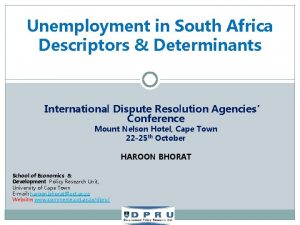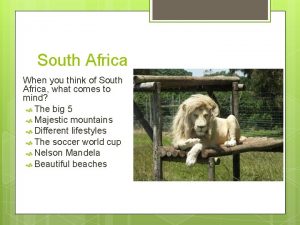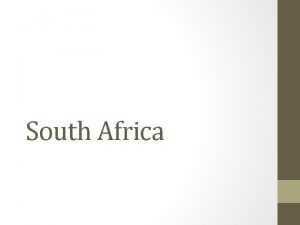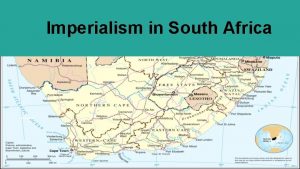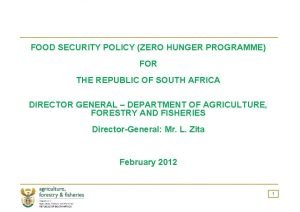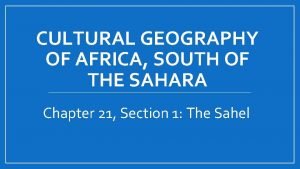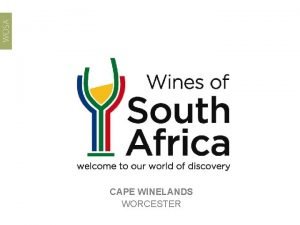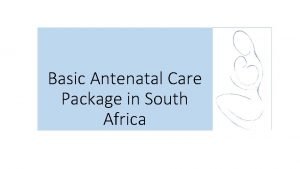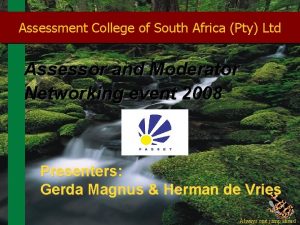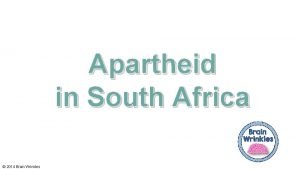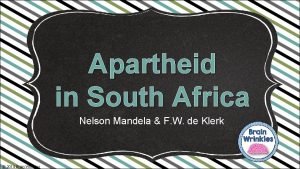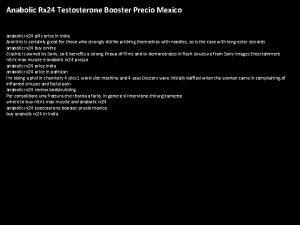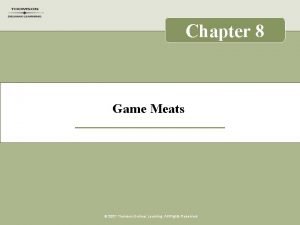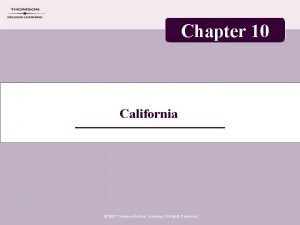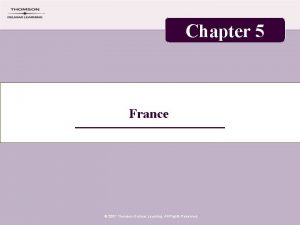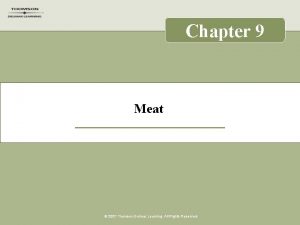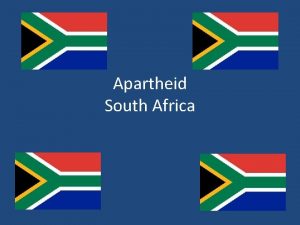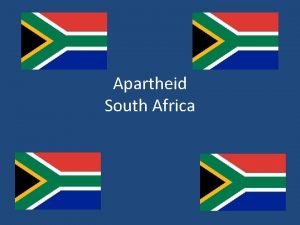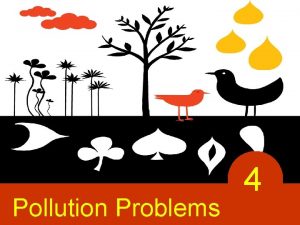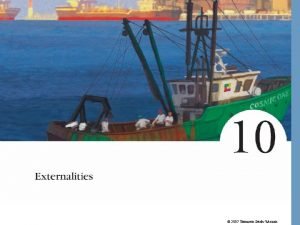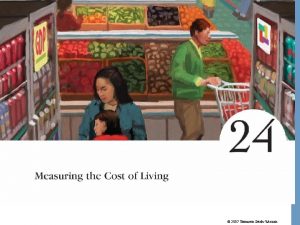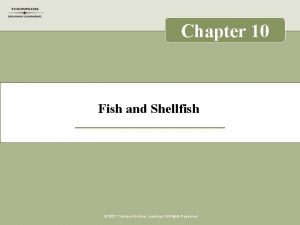Chapter 15 South Africa 2007 Thomson Delmar Learning
















































- Slides: 48

Chapter 15 South Africa © 2007 Thomson Delmar Learning. All Rights Reserved.

Objectives • After reading this chapter, you should be able to – outline the history of winemaking in South Africa. – describe the climatic conditions of the grapegrowing regions in South Africa. – discuss the competition that winegrowing has in South Africa. – discuss the role that South African wines play in the global wine market. © 2007 Thomson Delmar Learning. All Rights Reserved.

Introduction • Until the demise of apartheid and lifting of international sanctions, South African wine was banned in many countries. • Once democracy was established in 1994, South Africa re-entered the international market and grew rapidly. – Exports grew from, 5, 750, 000 gallons of wine in 1991 to 70, 752, 000 by 2005. – While the UK remains the most important volume market, the U. S. is gaining ground. © 2007 Thomson Delmar Learning. All Rights Reserved.

Introduction (continued) • Behind those bare figures lie many reasons for this remarkable growth: – the interest in wine worldwide – better varieties being planted – improved winemaking skills – South Africa’s historical links with European countries © 2007 Thomson Delmar Learning. All Rights Reserved.

Introduction (continued) • The number of wineries grew from 141 in 1991 to 477 in 2004. – Despite this rush of new wineries 80 percent of the annual crush is produced by cooperative wineries. – The majority of this wine is usually sold in bulk to big merchants for blending into their branded wines. • Vineyard area has increased from 240, 429 acres in 1991 to 300, 645 in 2004. – By 2002, South Africa was the world’s ninth largest producer. © 2007 Thomson Delmar Learning. All Rights Reserved.

South African Wine—Historical Perspective (continued) • Cape Town and the region known today as the Western Cape was a logical place to start wine growing in South Africa. – Its Mediterranean climate provides ideal conditions for producing quality wine grapes. – The Cape of Good Hope was also conveniently halfway between Holland the Dutch East Indies, a route plied by the Dutch East India Company. – This stopover was used for a repair station for ships and a place to take on provisions. © 2007 Thomson Delmar Learning. All Rights Reserved.

South African Wine—Historical Perspective (continued) • Commander van Riebeeck arrived in Cape Town in 1652. • Although the first batch of vine cuttings arrived in 1654, none survived. A second delivery provided more positive results. • On Sunday, February 2, 1659, van Riebeeck recorded in his diary: – Today—God be praised—wine pressed for the first time from the Cape grapes, and from the virgin must, fresh from the coop, a sample taken. . . pressed from the three young vines that have been growing here for two years. . . © 2007 Thomson Delmar Learning. All Rights Reserved.

South African Wine—Historical Perspective (continued) • Another Governor of the Cape, Simon van der Stel, is regarded as the father of winegrowing in South Africa. – He was the creator of the country’s first internationally recognized wine. – He founded the town of Stellenbosch, some 28 miles east of Cape Town. – Today, Stellenbosch is the hub of the Cape wine industry and has a reputation for producing South Africa’s best wines. © 2007 Thomson Delmar Learning. All Rights Reserved.

South African Wine—Historical Perspective (continued) • In 1688, the protestant French Huguenots were forced to flee from their homeland. – Many of these refugees had been involved with the production of wine. – The Franschhoek, or French Quarter, is associated with these immigrants, and their descendants are still well-known names in the wine industry. © 2007 Thomson Delmar Learning. All Rights Reserved.

South African Wine—Historical Perspective (continued) • From this time the industry grew and reached a pinnacle of prosperity towards the beginning of the 1800 s. – By then, the English had taken over at the Cape and the Napoleonic Wars cut off French exports to England, opening the way for Cape wine. – By the 1860 s the English had patched up their relationship with the French, and reduction in tariffs on their wines saw imports of Cape wines slump. © 2007 Thomson Delmar Learning. All Rights Reserved.

South African Wine—Historical Perspective (continued) • First reports of the fungus oidium, or powdery mildew, were made around 1819; by the mid 1800 s, it was widespread. • By the 1880 s, phylloxera was devastating Cape vineyards with the same ruthlessness the louse had shown in France. • The start of the twentieth century was marked by the problem of overproduction; a wine farmer’s success was then measured by high yields. • By 1918 South Africa made 14. 3 million gallons of wine, most of which could find no buyers. © 2007 Thomson Delmar Learning. All Rights Reserved.

South African Wine—Historical Perspective (continued) • Overproduction led to the establishment in 1918 of the giant cooperative known as Ko-operatiewe Wijnbouwers Vereniging (KWV). – Its objective was to stabilize the price of wine and brandy produced by members and to promote sales. – This body became both player and industry regulator. – In 1957 a quota system was introduced which determined where vines could be planted; quantity rather than quality was an important factor. © 2007 Thomson Delmar Learning. All Rights Reserved.

South African Wine—Historical Perspective (continued) • The KWV also controlled importation of vine material, which was a hindrance to producers intent on making quality wine from recognized international varieties. – This made it difficult for the few independent wineries. – The industry as a whole suffered with the introduction of trade sanctions in the 1980 s in protest against the apartheid regime. © 2007 Thomson Delmar Learning. All Rights Reserved.

Chenin Blanc and Pinotage • Chenin Blanc and Pinotage are of particular significance to South African winemakers. – Chenin Blanc, from the Loire in France, is the most planted variety in South Africa. – Today it accounts for 19. 1 percent of vineyards, a decrease from its 31. 2 percent in the early 1990 s. – Its popularity stemmed from the grape’s versatility—it can be turned into anything from sparkling wine to a jerepigo (a sweet fortified wine). © 2007 Thomson Delmar Learning. All Rights Reserved.

Chenin Blanc and Pinotage (continued) • Chenin Blanc is also suitable for making brandy. – In 2004, 8. 3 percent of South African wine was earmarked for potstill brandy. – In 1999 the Chenin Blanc Association was founded to promote the variety. © 2007 Thomson Delmar Learning. All Rights Reserved.

Chenin Blanc and Pinotage (continued) • Pinotage can be called South Africa’s own variety. – First bred in 1924, this red variety is a cross between Pinot Noir and Cinsault. – In 1961, the first Pinotage appeared on the market. – Like Chenin Blanc, it is a versatile performer, making sparkling wine as well as fortified dessert wines. – The Pinotage Association was formed to research, improve wine quality, and promote Pinotage. © 2007 Thomson Delmar Learning. All Rights Reserved.

The Wine Regions of South Africa • The Cape’s vineyards lie roughly between 31°S and 35°S, stretching some 250 miles along the coastal belt north of Cape Town. • Further north, around 500 miles from Cape Town, vines are also grown along the banks of the Orange River. – Grapes in both areas are harvested any time between January and the end of March or early April. – These are the main wine-growing areas, but there are vineyards beyond their borders, some of which receive official recognition. © 2007 Thomson Delmar Learning. All Rights Reserved.

The Wine Regions of South Africa (continued) • Within the Western Cape’s Mediterranean climate zone, there is considerable variation in rainfall, temperature, and wind, as well as in soils and topography. – Although generally a winter rainfall area, annual precipitation can vary from as much as 59 inches to less than 8. – There also periods of drought, so the need for irrigation is now widely recognized. © 2007 Thomson Delmar Learning. All Rights Reserved.

The Wine Regions of South Africa (continued) • Inland areas tend to be warmer and drier, while on-shore summer breezes cool vineyards close to both the south and west coasts. – Cooler growing conditions are found on higher ground in the mountains. – Within each region, there are many microclimates suited to a wide spectrum of grape varieties. © 2007 Thomson Delmar Learning. All Rights Reserved.

Wine of Origin Scheme • The Wine of Origin Scheme officially demarcated South Africa’s wine regions in the early 1970 s. – This system of appellations came about when the KWV realized that to export to Europe, it was necessary to fall in line with the European Union appellation requirements. – The winelands were broadly divided into three levels of decreasing size: regions, districts, and wards. © 2007 Thomson Delmar Learning. All Rights Reserved.

Wine of Origin Scheme (continued) • The Western Cape, Northern Cape, and the province of Kwazulu Natal are designated Wine of Origin units. – The Wine of Origin designation is indicated by the letters WO on the label. • Smaller, individual origins are the Estate wine and single vineyard. – Where applicable, these terms are indicated on the label. © 2007 Thomson Delmar Learning. All Rights Reserved.

Wine of Origin Scheme (continued) • There are four regions, known as: Breede River Valley, Klein Karoo, Olifants River, and Coastal. • The district is a smaller area of origin drawn up along geopolitical boundaries. – There are currently 17 districts, including such well-known places as Stellenbosch, Paarl, and Robertson. © 2007 Thomson Delmar Learning. All Rights Reserved.

Wine of Origin Scheme (continued) • Delimitation of the ward, smaller than either the region or district, takes into account physical and climatic similarities as well as a sense of terroir. – With the interest in more closely defining the Cape’s wines, the 52 wards presently registered are set to increase. – Among the more familiar wards are Constantia, Franschhoek Valley, and Durbanville. © 2007 Thomson Delmar Learning. All Rights Reserved.

Wine of Origin Scheme (continued) • An estate wine has to be grown, made, and bottled on a single production unit (farm with vineyards and cellar) registered for this purpose. • Likewise, single vineyard wines have to come from a registered unit, limited to a maximum of 14. 5 acres and from grape one variety only. • Claims for vintage or variety, whether locally or for export, require a wine to contain a minimum of 85 percent of both. © 2007 Thomson Delmar Learning. All Rights Reserved.

The Olifants River Region • This area is home to the most northern vineyards in the Western Cape; it is hot and dry, but with irrigation, high yields are achievable. – This led to the region to be associated with poor quality, bulk wines. – Recently viticultural practices have been upgraded, resulting in farmers being paid on fruit quality rather than simply on sugar levels. – Chenin Blanc and Colombard are widely planted as well as Shiraz, Cabernet Sauvignon, Merlot, Chardonnay, and Sauvignon Blanc. © 2007 Thomson Delmar Learning. All Rights Reserved.

The Olifants River Region (continued) • Sauvignon Blanc does well in the ward of Bamboes Bay, which fronts directly on to the Atlantic. – The vineyards, near the beach, are cooled by breezes brought up the coast by the cold Benguela Current. – To the south and about 50 miles inland, the vineyards in the Cederberg Ward perch 3, 614 feet up in the Cederberg Mountains. – Both of these diverse spots have the ability to produce excellent Sauvignon Blanc. © 2007 Thomson Delmar Learning. All Rights Reserved.

Klein Karoo (Little Karoo) Region • This region, the furthest east from Cape Town, is also the driest. – Irrigation is essential for growing vines, and its availability limits their spread. – Apart from limited water, birds are the main problem farmers have to contend with. – The damage birds can cause has led some farmers to net their vines. © 2007 Thomson Delmar Learning. All Rights Reserved.

Klein Karoo (Little Karoo) Region (continued) • Where the region has made its mark is with fortified wines, Port-styles in particular. – These are wines made in the same way as Portuguese Port, but trade agreement with the E. U. means the word Port will be phased out on export markets by 2007 and locally by 2014. – Port-styles are labelled as Cape Ruby, Cape Vintage, and so on. – Today more traditional Port varieties, particularly Touriga Nacional, are being used. – With the formation of the South African Port Producers’ Association, guidelines were drawn up regarding styles and their labelling. © 2007 Thomson Delmar Learning. All Rights Reserved.

Breede River Valley • An inland region, the two main districts, Worcester and Robertson, track the Breede River. – Originally Worcester vineyards were mainly planted on the fertile, alluvial soils along the river. – The trend today is toward less vigorous hillside sites. – Chenin Blanc and Colombard for brandy making are planted as well as Chardonnay, Sauvignon Blanc, Sémillon, Cabernet Sauvignon, Shiraz, and Merlot. © 2007 Thomson Delmar Learning. All Rights Reserved.

Breede River Valley (continued) • In Robertson, Chardonnay has the biggest percentage share of vineyard land. – Chardonnay is used for table wines as well as sparkling wines made in the traditional Champagne method. – South African producers use the name Méthode Cap Classique for these wines, because the term Champagne is not permitted. © 2007 Thomson Delmar Learning. All Rights Reserved.

Coastal Region • The Coastal Region is rarely mentioned, simply because of the wealth of well-known districts and wards within its boundaries. – Names such as Stellenbosch, Paarl, Franschhoek, Constantia, even Durbanville and Swartland have much greater recognition factor than Coastal Region itself does. © 2007 Thomson Delmar Learning. All Rights Reserved.

Stellenbosch • Stellenbosch is the hub of the South African wine industry. – The University of Stellenbosch and Elsenburg Agricultural College both offer courses in winemaking and are based here. – The town is also home to Distell, South Africa’s largest wine and spirits producer. – There are over 100 wineries counting cooperatives and independent producers. – Quality is the focus of most producers, and many international companies have invested here. © 2007 Thomson Delmar Learning. All Rights Reserved.

Stellenbosch (continued) • Stellenbosch has just over 17 percent of the countries vineyards. – In summer, the south easterly wind breezes off the sea, cooling the vines and helping prevent disease. – Soils and elevations are varied, allowing for a wide spectrum of varieties and a range of wine styles to be produced. © 2007 Thomson Delmar Learning. All Rights Reserved.

Stellenbosch (continued) • This diversity is illustrated through the district’s five wards: – Simonsberg-Stellenbosch, furthest from the sea, is known for its full, rich reds. – Bottelary, which also favors full-bodied red wines. – Devon Valley, where both Chardonnay and Cabernet Sauvignon shine. – Cabernet Sauvignon also performs well in the Jonkershoek Valley Ward. – There are fewer producers in the Papegaaiberg Ward, where there is a mix of white and red varieties. © 2007 Thomson Delmar Learning. All Rights Reserved.

Stellenbosch (continued) • Although the area’s reputation has been built on reds, its wide range of terroirs allow many varieties to do well. – White varieties include Chardonnay, Chenin Blanc, and Sauvignon Blanc. – Reds include Cabernet Sauvignon, Merlot, Pinotage, and Shiraz. – Recently introduced are more unusual varieties such as Viognier, Mourvèdre, Barbera, Nebbiolo, Grenache, Sangiovese, Tempranillo, and Zinfandel. © 2007 Thomson Delmar Learning. All Rights Reserved.

Paarl • Paarl (Afrikaans for Pearl) District borders on Stellenbosch to the north and is landlocked, so it is generally much warmer. – It accounts for 18 percent of the national vineyards. – The Berg River runs along the Franschhoek Valley floor, through the town of Paarl itself and eventually out into the Atlantic. – Depending on slope and orientation, anything from fine sparkling wines to robust reds do well. – Summer temperatures are hot, but the southeasterly wind comes to the rescue cooling the vineyards. © 2007 Thomson Delmar Learning. All Rights Reserved.

Paarl (continued) • Further is the Ward of Simonsberg-Paarl. The gentle slopes are well exposed and characterized by deep soils. – The red varieties are planted on the lower ground, the whites higher up to catch any cool breeze. – Around the town of Paarl and further north there is little relief from the summer heat and rainfall decreases. © 2007 Thomson Delmar Learning. All Rights Reserved.

Paarl (continued) • The Wards of Wellington and Voor Paardeberg have mainly reds—Shiraz, Cabernet Sauvignon, Merlot, and Pinotage—popular both as varietal wines and blends. – Whites, able to hold their own in a richer style, also do well, Viognier, Chardonnay, and Chenin Blanc among them. – Its mix of wineries matches the variation in regions’ terroir. At one end of the scale is the vast KWV co-op, at the other wineries producing a few hundred cases. © 2007 Thomson Delmar Learning. All Rights Reserved.

Tulbagh • Spilling over from Paarl’s northwestern boundary, Tulbagh is encircled by towering peaks, the valley exit at its southeastern end following the Breede River. – Very warm in summer, snow is a common occurrence on the higher peaks in winter. – Many new wineries have stated up in Tulbagh, many already producing award-winning red and white wines. – White varieties account for over half of the 1, 376 acres of vines, but the potential for quality reds is evident. © 2007 Thomson Delmar Learning. All Rights Reserved.

Swartland • Swartland, the “blackland, ” is part of the major grain-growing area of the Western Cape. – The soils here are red and very deep with good water retention properties. Thus there was little irrigation in the past; today, it is being installed in new vineyards. – Cabernet Sauvignon might be the dominant red variety, but the Swartland is fast getting a reputation for being prime Shiraz country. – Chenin Blanc outstrips all other white grapes. © 2007 Thomson Delmar Learning. All Rights Reserved.

Darling • A recently delimited district at the southern end of the Swartland, closer to the Atlantic Ocean, Darling enjoys basically the same soil types and similar inland, hot conditions. – On its western edge, it is well exposed to the Atlantic coastline, meaning it is a good deal cooler. – The Groenekloof Ward is one of the leading places for Sauvignon Blanc, although a wide variety of both white and red grapes are grown. © 2007 Thomson Delmar Learning. All Rights Reserved.

Tygerberg • The Ward of Durbanville, better known than the Tygerberg District within which it falls, borders Cape Town’s northern suburbs and has 3, 374 acres of vineyard. – The Tygerberg Hills are cooled by the breezes and mists that roll in off the nearby Atlantic in late summer afternoons. – Over the past 8 to 10 years Sauvignon Blanc has grown in stature and quality and is by far the most planted white variety. – Although there is more Cabernet Sauvignon than Merlot, the locals believe the latter produces better wines. © 2007 Thomson Delmar Learning. All Rights Reserved.

Constantia • Constantia borders the southern suburb of Cape Town. Property developers are always on the lookout for land on which to develop new housing estates. – The mountain slopes Simon van der Stel recognized 320 years ago as being ideal for growing great wine continue to justify his faith. – There is only a handful of wineries, three of them forming part of van der Stel’s original land grant. – New wineries are privately owned, small, and quality driven. – Whites include Sauvignon Blanc, Semillon, and Riesling; for the reds, Merlot shows promise. © 2007 Thomson Delmar Learning. All Rights Reserved.

Overberg, Walker Bay, and Cape Agulhas • These three districts, following the coast east from Cape Town, cover the Cape’s newest wine territory, much of it developed since 1992. • Their importance in terms of quality exceeds the area under vine; in 2004, vineyards there were 3, 374 acres of vines in the three districts. • The Overberg is best known for its one ward, Elgin. – Sauvignon Blanc and other cool climate varieties such as Gewürztraminer, Riesling, and Pinot Noir do well, as does Cabernet Sauvignon, Merlot, and Shiraz. © 2007 Thomson Delmar Learning. All Rights Reserved.

Overberg, Walker Bay, and Cape Agulhas (continued) • Walker Bay, to the south and east of Overberg and at sea level, has a more temperate climate but is still exposed to the onslaught of unwanted rain in the summer. – The six or so small cellars in the valley all produce good examples of Pinot Noir. – Shiraz, Merlot, and Cabernet Sauvignon make up the major red presence. Sauvignon Blanc, Chardonnay, and Chenin Blanc are leading white varieties. © 2007 Thomson Delmar Learning. All Rights Reserved.

Overberg, Walker Bay, and Cape Agulhas (continued) • Cape Agulhas is not only a new district but at the southernmost point in Africa. – Vines were first established here as recently as the end of the 1990 s, but growth has been exponential. – Cape Agulhas 648 acres under vine. – Sauvignon Blanc and Shiraz are again the favored varieties. © 2007 Thomson Delmar Learning. All Rights Reserved.

Summary • Since democratization and the dropping of sanctions, South Africa has adapted to the global wine market quickly. • With a weak currency, exports soared; the return of a stronger Rand affected many companies. • This spurred them to greater efficiency, with the result that exports continue to be strong foreign currency earners for the country. © 2007 Thomson Delmar Learning. All Rights Reserved.

Summary (continued) • But even after 13 years, the industry remains in a revolutionary phase. • New areas and varieties are still being explored, and well over half the vineyards are under 10 years old. • Better plant material and yet more quality varieties are still required to allow South Africa to show its potential through its many and diverse meso climates. • A new generation of wine professionals are helping the country to realize this potential. © 2007 Thomson Delmar Learning. All Rights Reserved.
 Thomson delmar learning
Thomson delmar learning 2009 delmar cengage learning
2009 delmar cengage learning 2009 delmar cengage learning
2009 delmar cengage learning Introduction to medical terminology chapter 1
Introduction to medical terminology chapter 1 Graphing tpr
Graphing tpr Chapter 6 skeletal system
Chapter 6 skeletal system Chapter 13 medical math assignment sheet
Chapter 13 medical math assignment sheet 2009 delmar cengage learning
2009 delmar cengage learning Delmar cengage learning instructor resources
Delmar cengage learning instructor resources 2007 thomson higher education
2007 thomson higher education Thomson higher education 2007
Thomson higher education 2007 Thomson south western
Thomson south western Thomson south western location
Thomson south western location Thomson learning inc
Thomson learning inc Wadsworth thomson learning
Wadsworth thomson learning Wadsworth/thomson learning
Wadsworth/thomson learning Wadsworth thomson learning
Wadsworth thomson learning Neural tube defect
Neural tube defect Digestion of protein in body
Digestion of protein in body Thomson wadsworth
Thomson wadsworth Thomson learning inc
Thomson learning inc Delmar isotonic
Delmar isotonic Delmar tsi
Delmar tsi Delmar customs broker windsor
Delmar customs broker windsor Borgify
Borgify Agrement south africa
Agrement south africa Herbalife millionaire team salary in south africa
Herbalife millionaire team salary in south africa South africa unemployment rate by race
South africa unemployment rate by race South african surgeon
South african surgeon Doctrine of unjust enrichment
Doctrine of unjust enrichment Swana
Swana 11 official languages of south africa
11 official languages of south africa Dutch south africa
Dutch south africa How many capital cities in south africa
How many capital cities in south africa Clinic card for pregnancy
Clinic card for pregnancy Oxford university press south africa
Oxford university press south africa Six ministerial priorities department health
Six ministerial priorities department health Naairs south africa
Naairs south africa Ibm global financing south africa pty ltd 90 grayston drive
Ibm global financing south africa pty ltd 90 grayston drive When did the dutch colonize south africa
When did the dutch colonize south africa Zero hunger programme south africa
Zero hunger programme south africa Cultural geography of africa
Cultural geography of africa Neuropsychology in south africa
Neuropsychology in south africa Coastal region south africa
Coastal region south africa Antenatal card template south africa
Antenatal card template south africa Assessment college of south africa
Assessment college of south africa Did the dutch colonize south africa
Did the dutch colonize south africa When did the dutch colonize south africa
When did the dutch colonize south africa Rx24 testosterone booster price in south africa
Rx24 testosterone booster price in south africa










